
A truss bridge is a bridge whose load-bearing superstructure is composed of a truss, a structure of connected elements, usually forming triangular units. The connected elements may be stressed from tension, compression, or sometimes both in response to dynamic loads. The basic types of truss bridges shown in this article have simple designs which could be easily analyzed by 19th and early 20th-century engineers. A truss bridge is economical to construct because it uses materials efficiently.
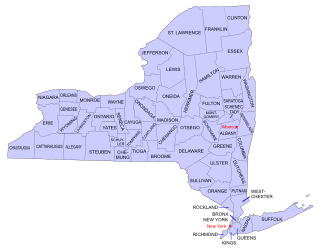
Buildings, sites, districts, and objects in New York listed on the National Register of Historic Places:
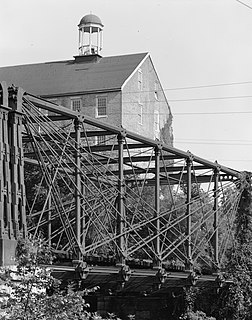
The Bollman Truss Railroad Bridge at Savage, Maryland is the sole surviving example of a revolutionary design in the history of American bridge engineering. The 160-foot (48.8 m) double-span is a suspension truss bridge. The first Bollman bridge was installed on the site; however, the current bridge is not the original. The current bridge was built in 1852 and moved to the site thirty years later. It is one of the oldest standing iron railroad bridges in the United States. Currently, however, it is in use carrying the Savage Mill Trail across the Little Patuxent River.

The Tower Bridge is a vertical lift bridge across the Sacramento River, linking West Sacramento in Yolo County to the west, with the capital of California, Sacramento, in Sacramento County to the east. It has also been known as M Street Bridge. It was previously a part of U.S. Route 40 until that highway was truncated to east of Salt Lake City as well as US Route 99W, which served the western portion of the Sacramento Valley from Sacramento to Red Bluff. The bridge is maintained by the California Department of Transportation as part of State Route 275 and connects West Capitol Avenue and Tower Bridge Gateway in West Sacramento with the Capitol Mall in Sacramento.
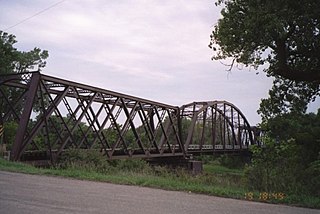
The Republican River Pegram Truss is a bridge located near Concordia, Kansas that is listed on the National Register of Historic Places. It is a three-span through truss bridge over the Republican River on route 795, northeast of Concordia. The bridge was built in 1893 by the Edge Moor Bridge Works of Wilmington, Delaware.
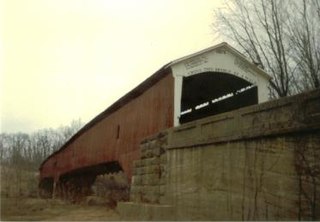
The West Union Covered Bridge formerly carried Tow Path Road over Sugar Creek north-northeast of Montezuma, Indiana. The two-span Burr Arch Truss covered bridge structure was built by Joseph J. Daniels in 1876. It is notable for being the longest standing covered bridge in Parke County, and one of the nation's best-preserved examples of the Burr truss.
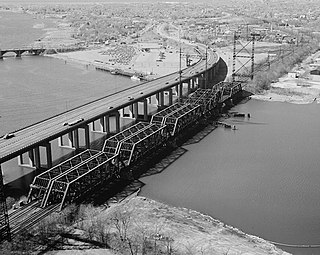
The Housatonic River Railroad Bridge is a historic bridge carrying Metro-North Railroad's New Haven Line trackage across the lower Housatonic River in the U.S. state of Connecticut. The bridge is also used by Amtrak for its Northeast Corridor services. It was listed on the National Register of Historic Places in 1987, which also refers to the bridge as the Devon Bridge. It is also referred to as the Devon Railroad Bridge by the state Department of Environmental Protection.
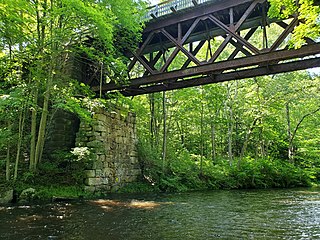
The Blackledge River Railroad Bridge is a Warren truss bridge that was built on the site of a c. 1870 railroad bridge. The original bridge was completed and opened by August 3, 1877. Likely built by the Colchester Railway Company, the bridge was part of the 3.59 miles (5.78 km) of track from Colchester, Connecticut, to Turnerville. The line was leased to the Boston & New York Air Line Railroad and reported improvement in 1879 and a new 110-foot long (34 m) iron bridge by 1881. The line was leased to the New York, New Haven and Hartford Railroad in 1882. After dominating the region, the New York, New Haven and Hartford Railroad petitioned for changes to the Air Line and the approval came on July 7, 1911.

The Broadway–Livingston Avenue Historic District is located at the junction of those two streets in Albany, New York, United States. It includes seven buildings remaining from an original 20, all contributing properties, and a Warren truss railroad bridge. In 1988 the area was recognized as a historic district and listed on the National Register of Historic Places.
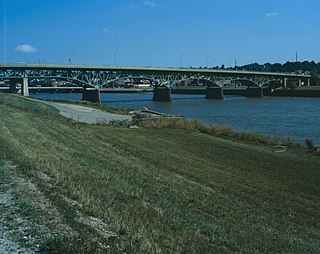
The Jefferson Street Viaduct is an historic structure located in Ottumwa, Iowa, United States. The riveted Warren deck truss bridge was completed in 1936. It was listed on the National Register of Historic Places in 1998 as a part of the Highway Bridges of Iowa MPS.

Linville Creek Bridge is a historic Thacher truss bridge located near Broadway, Rockingham County, Virginia. It was built by the Wrought Iron Bridge Company in 1898. It is a single span, measuring 135 feet 11 inches (41.43 m) long. This bridge was formerly identified as a hybrid Whipple, incorporating aspects of both the double-intersection Pratt and the double-intersection Warren. The structure in actuality is a Thacher truss, a hybrid configuration incorporating elements of the Pratt, Warren, Fink, and Bollman trusses that was first patented by Edwin Thacher in 1883. Its unusual configuration and the bewildering number of descriptions that have been applied to it merely reinforce its position as a bridge that is a rare survivor of an uncommon form.
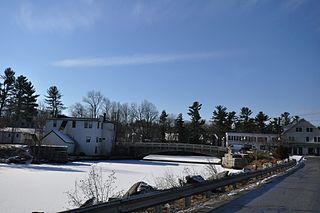
The Goffstown Covered Railroad Bridge was a rare railroad covered bridge in Goffstown, New Hampshire. It was built in 1901 by the Boston and Maine Railroad, on the site of an earlier bridge built in 1850 by the New Hampshire Central Railroad, and carried its tracks across the Piscataquog River in the center of Goffstown. The bridge was listed on the National Register of Historic Places in 1975. It was destroyed by arson in 1976, as would later be the case with the Hillsborough Railroad Bridge in 1985.
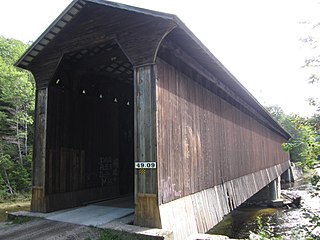
Wright's Bridge is a historic covered bridge in Newport, New Hampshire. Originally built in 1906 to carry the Boston and Maine Railroad across the Sugar River, it now carries the multi-use Sugar River Trail. The bridge was listed on the National Register of Historic Places in 1975.

The Ryefield Bridge is a historic bridge connecting Ryefield Bridge Road in Harrison, Maine, to West Andrew Hill Road in Otisfield, Maine, across the Crooked River. Built in 1912, it is one of the oldest surviving Warren truss bridges in the state, and is a rare example with double-intersection diagonals, added for increased rigidity. The bridge was listed on the National Register of Historic Places in 1999.

Starke County Bridge No. 39 is a single span Warren Pony Truss structure. The bridge is located on the northern outskirts of the small town of Knox, Indiana, where Main and Water Streets terminate at the former Penn Central Railroad cut. The bridge spans the rail cut in a northwest–southeast direction, allowing access to Wythougan Park.
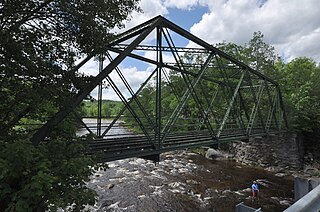
The Medburyville Bridge is a historic bridge in Wilmington, Vermont. It is a steel Warren through bridge, built in 1896 across the Deerfield River, just south of Vermont Route 9 roughly midway between the centers of Wilmington and Searsburg. It stands just upstream of the Woods Road bridge, which functionally replaced it in 1985. The bridge was listed on the National Register of Historic Places in 1990; as it has no decking, it is closed to all forms of traffic.

The Rice Farm Road Bridge is a historic bridge in Dummerston, Vermont. It is an iron Warren through truss, spanning the West River between Vermont Route 30 and Rice Farm Road. Built in 1892, it is one of the state's oldest surviving metal truss bridges. It was listed on the National Register of Historic Places in 1995.

The Woodstock Warren Through Truss Bridge was a historic iron bridge that carried Bridges Road across the Ottauquechee River in western Woodstock, Vermont. The bridge was built in 1925, and was a rare example of the state of a double-intersection Warren through truss. The bridge was swept away by flooding caused by Hurricane Irene in 2011; it was listed on the National Register of Historic Places in 1992.

The Long Cove Creek railway viaducts are heritage-listed railway viaducts which carry the Main Suburban railway line over Long Cove Creek between the suburbs of Lewisham and Summer Hill in Sydney, New South Wales, Australia. The viaducts were designed and built by the New South Wales Government Railways. The property is owned by RailCorp, an agency of the Government of New South Wales. It was added to the New South Wales State Heritage Register on 2 April 1999.
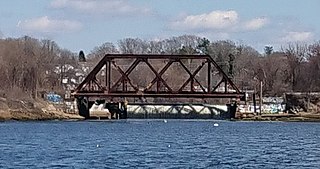
The Omega Pond Railroad Bridge is a railroad bridge spanning the western end of Omega Pond in East Providence, Rhode Island. The bridge is a contributing structure to the Phillipsdale Historic District listed on the National Register of Historic Places.






















